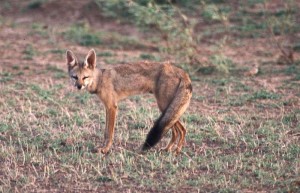The Bengal Fox
Bongsong · 9 months ago
In India, Bangladesh and Nepal, the most common type of fox is the Bengal Fox. When compared with the common red fox, it is much slighter in appearance and has a more pointed nose along with a distinct black tip on it’s tail. Commonly weighing between 2-4kgs and with a life expectancy of around 11 years, the Bengal Fox enjoys hunting alone at either end of the day, out of the intense heat of it’s surroundings. Like the red fox, the Bengal fox likes to dig a complicated network of tunnels to use as a hiding place and to give birth to and bring up their young. The litter varies between 3-6 cubs and the diet of the Bengal Fox is quite varied, ranging from rodents to insects to fruit. Interestingly, studies have shown that the Bengal fox does not mark it’s territory with urine or faeces. This is unusual because defecation to claim an area is a very defining characteristic of the red fox, as many frustrated gardeners will testify to in urban areas! Unfortunately the Bengal Fox is not thriving like it’s red counterparts. The threat of man is increasingly cutting the numbers of Bengal foxes due to both habitat destruction and hunting. The Bengal fox’s preferred areas to inhabit are open pieces of grassy land and scrub. Due to the increase of converting land for use in agriculture and a lack of land protection in the Indian subcontinent, the habitats of the Bengal fox are getting smaller and smaller, obviously causing a decrease in it’s numbers. The foxes are also hunted for sports, for their fur in addition to some Indian tribes using fox teeth and tails in some medicines, believing them to have healing qualities. It is also not unknown for some people to catch the Bengal fox in order to eat it’s meat. Despite the Indian government issuing legislation in 1991 that forbids the hunting of Bengal foxes, because of the reasons given above, the legislation has had a limited impact and has failed to stop the decline in numbers. Alas it appears that the Bengal fox is a member of the fox family that is not going to survive for too many more generations, as in addition to a lack of habitat and hunting, the fox also faces a threat from wolves, dogs and disease (namely rabies and canine distemper). One would hope the vulpes bengalensis will make a bit of a comeback, but at the moment it unfortunately looks like a decline that will not be reversed.
